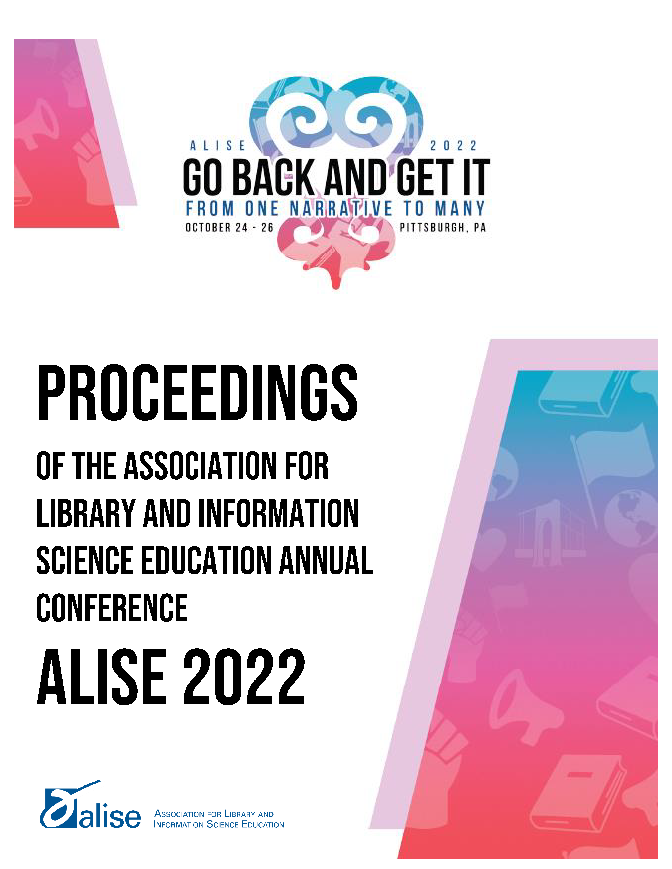Beyond Resilience
Children's Access to Reading Materials Relative to the COVID-19 Pandemic
DOI:
https://doi.org/10.21900/j.alise.2022.999Keywords:
access to reading materials, Coronavirus (COVID-19) pandemic, children's and young adult services, reading preferencesAbstract
This collection of three studies investigated children’s frequency of access to school and public library materials as well as format preferences and resources used to access reading materials prior to, during, and predicted after the COVID-19 pandemic. A survey of parents of children ages 2-18 was conducted which included demographics and other factors. Data were analyzed for significant differences over time and by subgroup. Results indicate that children’s frequency of access to reading materials was negatively influenced by school and library closures and limited access. The child’s age and school environment were influencing factors. Results also indicate differences in format preferences and types of resources used to access reading materials over time. Educators of school and public librarians hold a responsibility to instruct LIS students to prepare for resilience by teaching library patrons how to access and enjoy digital materials in transformative times.
References
American Association of School Librarians (2009). Empowering learners: Guidelines for school library programs. Chicago, Ill: American Association of School Librarians.
American Association of School Librarians (2018). National school library standards for learners, school librarians, and school libraries. Chicago: ALA Editions.
ALA/AASL/CAEP (2019) School librarian preparation standards. Accessed September 28, 2020 at: http://www.ala.org/aasl/sites/ala.org.aasl/files/content/aasleducation/ALA_AASL_CAEP_School_Librarian_Preparation_Standards_2019_Final.pdf
Aldrich, Rebekkah Smith (2018). Resilience. Chicago: American Library Association.
Association for Library Service to Children (ALSC) (2020). Public Library & School Library Collaboration Toolkit. Accessed September 28, 2020 http://www.ala.org/alsc/
Bennett, S. V., Gunn, A. A., & Peterson, B. J. (2021). Access to multicultural Children’s literature during COVID‐19. The Reading Teacher, 74(6), 785-796. https://doi.org/10.1002/trtr.2003
Berra, Daniel (2021). Utilizing technology to support and extend access to students and job seekers during the pandemic. Information Technology and Libraries (Online), 40(1), 1-3. doi: https://doi.org/10.6017/ital.v40i1.13261
Boltz, Robin H. (2007). What we want: Boys and girls talk about reading. School Library Media Research 10, 1-18.
Dolly Parton Imagination Library (2020). Accessed October 14, 2020 https://imaginationlibrary.com/
First Book (2022) Accessed March 7, 2022 https://firstbook.org/
Funge, S. P., Sullivan, D. J., & Tarter, K. (2016). Promoting Positive Family Interactions: Evaluating a Free Early Childhood Book Distribution Program. Early Childhood Education Journal, 45(5), 603-611. https://10.1007/s10643-016-0815-9
Gaver, MV (1963). Effectiveness of Centralized Library Service in Elementary Schools. New Brunswick, NJ: Rutgers University Press.
International Children’s Digital Library (n.d.). University of Maryland College of Information Studies. Accessed March 7, 2022 http://www.childrenslibrary.org/
Lance, KC, Kachel, DE (2018) Why school librarians matter: What years of research tell us. Phi Delta Kappan 99(7): 15–20.
Little Free Library (2022). Accessed March 7, 2022 http://www.childrenslibrary.org/
National Center for Education Statistics (NCES) (2016). Digest of education statistics chapter 2: Elementary and secondary education. Accessed October 15, 2020 https://nces.ed.gov/programs/digest/d16/ch_2.asp
Neuman, S. B., & Celano, D. (2001). Access to print in low-income and middle-income communities: An ecological study of four neighborhoods. Reading Research Quarterly, 36(1), 8. Retrieved from https://www.proquest.com/scholarly-journals/access-print-low-income-middle-communities/docview/212135513/se-2
Pribesh, S, Gavigan, K, Dickinson, G (2011) The access gap: Poverty and characteristics of school library media centers. Library Quarterly 81(2): 143–160.
Roni, S. M., & Merga, M. K. (2017). The Influence of Device Access and Gender on Children’s Reading Frequency. Public Library Quarterly, 36(4), 334-348. https://10.1080/01616846.2017.1354375
Scholastic Kids & Family Reading Report (7th ed.). (2020). Scholastic. Accessed September 30, 2020 https://www.scholastic.com/content/dam/KFRR/Downloads/KFRReport_Finding%20Their%20Story.pdf
Smith-Kang, S. (April 17, 2019). Read Conmigo- Free Children’s Books in English and Spanish. Accessed March 7, 2022 https://www.culturas.us/2019/04/17/free-childrens-books-in-english-and-spanish/
Soulen, R. & Tedrow, L. (n.d.). Children’s Access to Reading Materials Relative to the Coronavirus (COVID-19) Pandemic: Preferred Formats and Resources. [Unpublished manuscript].
Soulen, R. & Tedrow, L. (2021). Students’ frequency of access to school library materials in transformative times. Journal of Librarianship and Information Science. https://doi.org/10.1177/09610006211037721
Soulen, R. R., & Tedrow, L. (2022). Reading in transformative times: Children's frequency of access to public library materials relative to the coronavirus (COVID-19) pandemic. Journal of Library Administration, 62(4), 438-464. https://doi.org/10.1080/01930826.2022.2057126
Soulen, R, Tedrow, L, Sullivan, K (2020). Resilience in the aftermath: School libraries and rebounding after trauma. School Libraries Worldwide 26(2): 27–45.
Wine, LD (2020) Impact of school librarians on elementary student achievement (ProQuest number 27957323). Available at: https://digitalcommons.odu.edu/cgi/viewcontent.cgi?article=1063&context=teachinglearning_etds
YALSA (2020). Accessed October 15, 2020 http://www.ala.org/yalsa/
Downloads
Published
Issue
Section
License
Copyright (c) 2022 Rita Soulen

This work is licensed under a Creative Commons Attribution-ShareAlike 4.0 International License.



